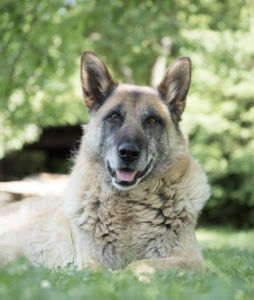 When the temperature starts to drop and the evenings get chilly, you might notice your dog moving a bit slower, stretching a bit longer, and perhaps hesitating before their usual jump onto the couch. As winter rolls in, dogs with arthritis often experience increased stiffness and discomfort. Here’s how you can help your furry friend stay comfortable during the cooler months.
When the temperature starts to drop and the evenings get chilly, you might notice your dog moving a bit slower, stretching a bit longer, and perhaps hesitating before their usual jump onto the couch. As winter rolls in, dogs with arthritis often experience increased stiffness and discomfort. Here’s how you can help your furry friend stay comfortable during the cooler months.
Arthritis, or osteoarthritis, is a degenerative joint disease that can affect dogs of all ages but is more common in older dogs. It causes inflammation and pain in the joints, leading to reduced mobility. As the weather gets colder, this pain can become more pronounced, making it crucial for dog owners to be vigilant in providing care and comfort.
Signs Your Dog Might Have Arthritis
If you’re unsure whether your dog is experiencing arthritis-related discomfort, here are some common signs to look out for:
- Limping or Lameness: Noticeable limping or favouring a particular leg can indicate joint pain.
- Difficulty Rising or Sitting: Dogs with arthritis may struggle to get up from a resting position or find it hard to sit down.
- Reduced Activity: A decrease in playfulness or reluctance to go for walks might suggest discomfort.
- Changes in Behaviour: Irritability or increased sensitivity when touched can be a response to pain.
 Creating a Warm and Comfortable Environment
Creating a Warm and Comfortable Environment
As the cooler weather sets in, you can take steps to make your home more comfortable for your arthritic dog:
- Provide Warm Bedding: Invest in orthopedic dog beds with extra padding to support sore joints. Place beds away from drafts and ensure they are warm and cozy.
- Use Heating Pads or Blankets: Consider using heating pads or electric blankets to provide gentle warmth to your dog’s sleeping area. Always use products designed for pets to ensure safety.
- Limit Cold Surfaces: Hardwood or tile floors can be uncomfortable for dogs with arthritis. Use rugs or non-slip mats to create a softer surface for them to walk on.
- Dress them in warm pet clothing: Jumpers and shirts may help keep your older pup feeling cozy and warm. Remember to be mindful to check that they are not too hot, and to take breaks from long periods of wear – especially for those with long coats which should be brushed after taking the clothing off to avoid tangles and matting.
 Tailoring Exercise and Activity
Tailoring Exercise and Activity
While it might seem counterintuitive, moderate exercise is essential for managing arthritis in dogs. It helps maintain joint flexibility and prevents muscle atrophy:
- Gentle Walks: Opt for shorter, more frequent walks to keep your dog moving without overexertion. Choose flat, even surfaces to reduce strain.
- Controlled Play: Engage in low-impact play, like gentle tug-of-war or indoor fetch with soft toys. Avoid activities that require jumping or rapid changes in direction.
- Hydrotherapy: If available, hydrotherapy can be an excellent way to exercise your dog with minimal stress on the joints. Swimming or water-based exercises are gentle yet effective.
Consulting with Your Vet
If your dog shows signs of arthritis, consulting with your vet is essential. They can recommend appropriate medications, supplements, or physical therapy to manage pain and improve mobility. Glucosamine, chondroitin, and omega-3 supplements are commonly used to support joint health.
…
 Managing arthritis in the cooler months requires patience and compassion. Remember that your dog might need extra help with activities that used to be easy. Offer support when they need it, whether it’s lifting them into the car or helping them up the stairs.
Managing arthritis in the cooler months requires patience and compassion. Remember that your dog might need extra help with activities that used to be easy. Offer support when they need it, whether it’s lifting them into the car or helping them up the stairs.
Most importantly, show your dog extra love and attention during this time. Gentle massages, snuggles on a warm blanket, and a comforting voice can go a long way in soothing their discomfort. With the right care, you can ensure your dog enjoys a cozy, pain-free winter season.